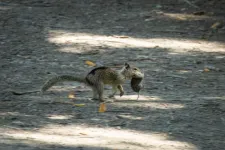(Press-News.org)
Just as some children physically resemble their parents, many scientists have long thought that developing planets should resemble the swirling disk of gas and dust that births them.
But, in a new study, a Northwestern University-led team of astrophysicists discovered the resemblance might be looser than previously thought. By studying a still-forming exoplanet and its surrounding natal disk, the researchers uncovered a mismatched composition of gases in the planet’s atmosphere compared to gases within the disk.
The surprising finding potentially confirms long-held skepticism that scientists’ current model of planet formation is too simplified.
The study will be published on Wednesday (Dec. 18) in the Astrophysical Journal Letters. It marks the first time physicists have compared information from an exoplanet, its natal disk and host star.
“For observational astrophysicists, one widely accepted picture of planet formation was likely too simplified,” said Northwestern’s Chih-Chun “Dino” Hsu, who led the study. “According to that simplified picture, the ratio of carbon and oxygen gases in a planet’s atmosphere should match the ratio of carbon and oxygen gases in its natal disk — assuming the planet accretes materials through gases in its disk. Instead, we found a planet with a carbon and oxygen ratio that is much lower compared to its disk. Now, we can confirm suspicions that the picture of planet formation was too simplified.”
Hsu is a postdoctoral associate at the Center for Interdisciplinary Exploration and Research in Astrophysics(CIERA). He is advised by Jason Wang, an assistant professor of physics and astronomy at Northwestern’s Weinberg College of Arts and Sciences and member of CIERA.
Searching for visible birth material
All planets are born from a natal disk, a rotating disk of gas and dust that surrounds a new star. Over millions of years, gravity pulls gas and dust together to form clumps, which eventually grow into planets. Until recently, it was impossible to obtain a direct view of a natal disk in order to track a planet’s birth. Most observable exoplanets are too old, so their natal disks have already disappeared.
The exception, however, is PDS 70, a natal disk that envelopes two fledgling gas-giant exoplanets — similar to Jupiter — called PDS 70b and PDS 70c. Located just 366 million lightyears from Earth within the constellation Centaurus, the planets are, at most, a youthful 5 million years old.
“This is a system where we see both planets still forming as well as the materials from which they formed,” Wang said. “Previous studies have analyzed this disk of gas to understand its composition. For the first time, we were able to measure the composition of the still-forming planet itself and see how similar the materials are in the planet compared to the materials in the disk.”
Examining planetary fingerprints
To measure the materials, Hsu, Wang and their team examined the light emitted from PDS 70b. This light, or spectra, is like a fingerprint, revealing an object’s composition, motion, temperature and other characteristics. Each molecule or element produces its own spectrum. So, by studying these spectra, researchers can pinpoint the specific molecules or elements within an object.
In previous work, Wang co-developed new photonics technologies that enable astronomers to capture the spectrum of targeted faint objects near much brighter stars. The researchers used this technique to zero in on the faint features of the young planetary system.
“These new tools make it possible to take a really detailed spectra of faint objects next to really bright objects,” Wang said. “Because the challenge here is there’s a really faint planet next to a really bright star. It’s hard to isolate the light of the planet in order to analyze its atmosphere.”
With the spectra, the researchers obtained information about carbon monoxide and water from PDS 70b. From that, they calculated the inferred ratio of carbon and oxygen within the planet’s atmosphere. Then, they compared that ratio to previously reported measurements of gases in the disk.
“We initially expected the carbon-to-oxygen ratio in the planet might be similar to the disk,” Hsu said. “But, instead, we found the carbon, relative to oxygen, in the planet was much lower than the ratio in the disk. That was a bit surprising, and it shows that our widely accepted picture of planet formation was too simplified.”
Solid components might make the difference
To explain this mismatch, Hsu and Wang think two different scenarios might be at play. One explanation is the planet might have formed before its disk became enriched in carbon. Another explanation is the planet might have grown mostly by absorbing large amounts of solid materials in addition to gases. While the spectra show only gases, some of the carbon and oxygen initially could be accreted from solid — trapped in ice and dust.
“If the planet preferentially absorbed ice and dust, then that ice and dust would have evaporated before going into the planet,” Wang said. “So, it might be telling us that we can’t just compare gas versus gas. The solid components might be making a big difference in the carbon to oxygen ratio.”
For this study, the team only studied PDS 70b. Next, they plan to observe the spectra from the other planet in the PDS 70 system.
“By studying these two planets together, we can understand the system’s formation history even better,” Hsu said. “But, also, this is just one system. Ideally, we need to identify more of them to better understand how planets form.”
The study, “PDS 70b shows stellar-like carbon-to-oxygen ratio,” was supported by the Heising-Simons Foundation, the Simons Foundation and the National Science Foundation.
END
A ground squirrel with cheeks stuffed with nuts, seeds or grains, is a common sight. But a new study provides the first evidence that California ground squirrels also hunt, kill and eat voles. The study, led by the University of Wisconsin-Eau Claire and University of California, Davis, is the first to chronicle widespread carnivorous behavior among squirrels.
Published in the Journal of Ethology, the study fundamentally changes our understanding of ground squirrels. It suggests that what was considered a granivorous species actually is an opportunistic omnivore and more flexible in its diet than was assumed.
The observations occurred in 2024 — the 12th year of the Long-term ...
Diagnosing osteoarthritis often occurs in the late stages when cartilage degradation is severe, making it difficult to distinguish it from other types of arthritis and to determine the best treatment plan. In work published in the Journal of Orthopaedic Research, investigators have developed and tested a new diagnostic test that uses two markers found in the synovial fluid of patients’ joints.
After assessing levels of cartilage oligomeric matrix protein and interleukin‐8, the team came up with an algorithm based on the ratio of these two markers and validated its efficacy in differentiating osteoarthritis from inflammatory arthritis in 171 human knee synovial ...
Among tree species in the Ecuadorian Amazon, investigators at the Universidad de las Américas, in Ecuador, found that 14% are critically endangered and 47% are endangered. The Plants, People, Planet study indicates that trees with smaller fruits face the greatest threats due to declines of specific animal species that disperse them.
The findings reveal that the extinction risk for endemic trees is associated not only with extrinsic factors such as deforestation but also with complex relationships with other living organisms in their environment.
“Thus, our results highlight the importance ...
Research published in the British Journal of Developmental Psychology indicates that the COVID-19 pandemic and lockdown had largely positive impacts on gender identity development in trans and gender diverse youth.
For the study, 295 transgender and gender diverse U.S. youth, ages 13–22 years, were asked the open-ended question “How has the COVID pandemic changed or affected your own understanding of your gender identity?”
Responses revealed several themes. The most prevalent was “time for identity development,” ...
Older adults with multiple chronic conditions may face a high risk of kidney function decline, according to new research published in the Journal of the American Geriatrics Society.
In the study, 3,094 older individuals from the Swedish National Study on Aging and Care in Kungsholmen were followed for 15 years.
There was an independent dose-response relationship between the number of chronic conditions and kidney function decline, so that as the number of chronic conditions increased, kidney function decline became more likely and steeper.
When considering the makeup of conditions rather than just ...
A new report in the journal Anatomical Sciences Education outlines best practices and standards for human body donation programs across the United States, which accept whole body donations after death for research and education.
The report, issued by a task force of American Association for Anatomy members, seeks to align body donation programs with evolving societal values and legal frameworks. It aims to maintain the highest ethical standards for donors by upholding the principles of informed consent, oversight, and dignity.
The report emphasizes the importance of ensuring potential donors and their families ...
Many infants in Sweden are given milk cereal drinks, ready-to-mix liquid drink complements to breast milk, after six months of age. New research in Acta Paediatrica found evidence that these products are linked to early rapid weight gain but not to higher anthropometric measures—such as body mass index or waist-to-height ratio—later in childhood.
In the study of 1,333 children from three communities in Western Sweden, physical characteristics and food habits were collected in 2007–2008 family surveys. Follow-up data for 656 children were collected in 2013–2014.
At baseline, 820 (62%) of the 658 boys and 675 girls consumed milk cereal drinks, and 229 (18%) had early ...
TAMEST (Texas Academy of Medicine, Engineering, Science and Technology) has announced Gerta Hoxhaj, Ph.D., Assistant Professor at the Children’s Medical Center Research Institute at UT Southwestern (CRI), as recipient of the 2025 Mary Beth Maddox Award and Lectureship in cancer research. She was chosen for her work in cancer metabolism and revealing new mechanisms crucial for the growth and survival of cancer cells.
The Mary Beth Maddox Award and Lectureship recognizes women scientists in Texas bringing new ideas and innovations to the fight against cancer. It was established in 2022 in honor of Mary Beth Maddox, former ...
Some people can’t imagine a dog barking or a police siren. Songs can’t get stuck in their heads. They have no inner voices.
‘Anauralia’ was proposed in 2021 by scientists from Waipapa Taumata Rau, University of Auckland to describe the little-known condition of a silent mind.
Now, as their investigations into the phenomenon continue, the University will host a global conference on sounds imagined in the mind, an event intended not just for scientists but also philosophers, musicians, poets and writers. ‘Mind’s ...
The increasing number of strokes and subsequent rehabilitation has highlighted the growing need for effective care strategies. Serious side effects, such as motor paralysis, can be challenging to mend, but the recent incorporation of robots into treatment has shown promise.
Automated robots repeatedly provide the proper movements necessary to recover motor function. However, to ensure appropriate care tailored to the degree of motor paralysis, knowledge of robots and rehabilitation is needed.
Osaka Metropolitan University Professor Takashi Takebayashi of the Graduate School of Rehabilitation Science led a team in collecting data from ...






